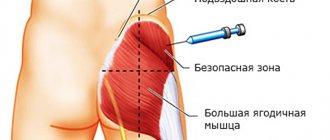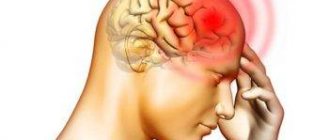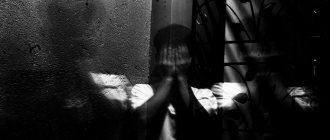According to anatomical studies by SS Hayreh (1954, 1957), GD. Zarubeya (1966), the blood supply to the optic nerve is carried out from the system of choroid plexuses of the pia mater (peripheral system) and the system of the central retinal artery - CAS (central system). The blood supply to the eyes, as well as the entire brain, is carried out by the branches of the aortic arch: the innominate artery (or brachiocephalic trunk) on the right and the common carotid and subclavian arteries on the left. The internal carotid artery, before entering the cranial cavity, is located in the neck and does not give off any branches throughout the entire length of the cervical spine. In the cranial cavity it passes through the cavernous sinus (sinus cavernosus). This part of the internal carotid artery is called the cavernous artery. Coming out of the cavernous sinus, it gives off its first large branch - the orbital artery (a. ophthalmica), which, together with the optic nerve, penetrates into the cavity of the orbit, where it breaks up into terminal branches. The branches of the ophthalmic artery anastomose with the middle meningeal artery, a branch of the external carotid artery. In this way, the basin of the internal and external carotid arteries is connected. After the ophthalmic artery departs, the internal carotid artery, located lateral to the chiasm, gives off a rather thin branch - the posterior communicating artery (a. communicans posterior), and then divides into 2 terminal branches: the middle cerebral artery (a. cerebri anterior) and the anterior cerebral artery (a. cerebri anterior). The anterior cerebral arteries of both sides are connected to each other by the anterior communicating artery. These vessels make up the anterior part of the circle of Willis. Its posterior part is formed by the vessels of the vertebrobasilar system. The vertebral artery originates from the subclavian artery and ascends, located in the openings of the transverse processes of the cervical vertebrae. It enters the cranial cavity through the foramen magnum, lies on the slope under the medulla oblongata, goes to the midline and merges with the vertebral artery of the other side into the unpaired basilar artery (a. basilaris). The main artery runs along the midline of the pons and divides into paired posterior cerebral arteries - the terminal branches of the vertebrobasilar system. The posterior cerebral arteries, with the help of the posterior communicating arteries, anastomose with the internal carotid artery, closing the circle of Willis. Thus, thanks to the circle of Willis, the basins of the internal carotid arteries and the vertebrobasilar system are united. The internal carotid artery supplies blood to the cerebral cortex (with the exception of the occipital lobes), eyeballs, optic nerves and partially the central parts of the visual analyzer. The circle of Willis, or polygon of Willis, uniting the carotid and vertebrobasilar systems, plays an extremely important role in collateral or replacement circulation. Complete blockage of the internal carotid artery in the neck can be asymptomatic due to the fact that blood circulation will be carried out through the circle of Willis. In this case, the ophthalmic artery plays an exceptional role - as a branch of the internal carotid artery with rich anastomoses with the external carotid artery.
Causes
Vision with VSD often remains within normal limits, but with a sharp vascular spasm, floaters may appear in the eyes. Attacks of vegetative-vascular dystonia are not always accompanied by this symptom.
Severe anxiety
Increased anxiety and accompanying psychological disorders often provoke the appearance of flies that run before the eyes. As a result of strong tension, vasoconstriction occurs, which contributes to changes in visual perception.
Nutrient deficiency
Eye pain and other symptoms of VSD occur due to a lack of nutrients: magnesium, phosphorus, potassium and other trace elements and vitamins. Such a deficiency can be caused by conditions accompanied by decreased immunity and poor nutrition.
Poor circulation
Blurry perception of images and the presence of floaters during VSD are provoked by insufficient blood circulation. As a result, the nutrition of the eyeball deteriorates, oxygen is supplied in less than necessary quantities.
Floaters in the eyes with VSD
Vegetative-vascular dystonia affects the functioning of various organs. The variety of symptoms makes diagnosis difficult. Eye floaters are one such controversial phenomenon. This sign can be as simple as blurred vision from fatigue, it can indicate the development of pathology of the visual system or signal a disorder such as VSD.
The role of the autonomic nervous system
The autonomic nervous system is responsible for regulating the functioning of all organs.
Salivation and changes in pupil size, increased body temperature and the production of digestive juices, acceleration and deceleration of the heart, changes in blood pressure - this is not a complete list of regulatory functions performed by different parts of the spinal cord.
The signal from it reaches the organ through nerve endings automatically, bypassing the brain.
The system consists of two sections that have the opposite effect: sympathetic (responsible for activating an organ or process) and parasympathetic (responsible for inhibiting the process, slowing it down). When the nerve connection between the spinal cord and one or another part of the body is disrupted, VSD occurs. Moreover, the organ itself does not have any pathological changes.
Symptoms of VSD
The disease is manifested by poor health, frequent headaches and emotional outbursts.
VSD has a wide range of symptoms. This is due to the complex effect of the autonomic nervous system on the entire body. It is in the system where there is a loss of balance between the spinal cord and the organ that the disorder occurs.
The patient undergoes a large number of examinations, trying to find the cause of the ailment. During the study, it turns out that the seemingly affected organ is healthy, and the person feels symptoms of vegetative-vascular dysfunction. After its correction, all painful sensations disappear.
However, if the manifestations of dystonia are not paid attention to, its symptoms can provoke a dangerous disease. Symptoms of VSD include:
- An increase or decrease in blood pressure, which is accompanied by visual disturbances in the form of spots before the eyes or a veil.
- Pain in the heart area, irregular heartbeat.
- Difficulty breathing, lack of air, yawning.
- Drowsiness or, conversely, sleep disorders.
- Abdominal pain, digestive system disorder.
- Frequent urination, menstrual irregularities (in women), the appearance of prostatitis (in men).
- Chills, numbness and coldness in the extremities or, conversely, a flush of heat to the face, sweating.
- Disturbances in the psycho-emotional sphere, a state of apathy.
Floaters before the eyes with VSD
To exclude or confirm a disease that may not be related to vision, consultation with a specialist is necessary.
Patients describe floaters in front of their eyes as white dots, sometimes with a black rim, flickering ribbons or bright spots. A person sees all these objects due to the fact that they do not transmit light.
Floaters can be a sign of various diseases: retinal detachment, destruction of the vitreous body, anemia, brain tumor, VSD, bleeding inside the eye, infectious diseases.
In addition, floaters and blurred vision may appear during pregnancy or be the result of taking certain medications.
Floaters as a symptom of VSD
With vegetative-vascular dysfunction, the patient's blood pressure can sharply increase or decrease. In both cases, cerebral blood flow is disrupted.
The blood vessels of the eyes also experience a lack of oxygen. Retinal ischemia begins, and the patient sees spots or flying spots before the eyes.
The condition is accompanied by dizziness, especially with a sudden change in body position.
Diagnosis of the disease
For effective treatment, you should undergo a detailed examination of the visual organs.
To exclude the presence of dangerous eye diseases, the symptom of which can also be floaters, the patient should contact an ophthalmologist for examination. The doctor examines the patient's fundus and performs ophthalmoscopy.
If the cause of the deviation is not in the visual analyzer, the patient is referred to a therapist and neurologist for further examination and an accurate diagnosis.
Treatment of the disease
If the appearance of visual deviations is caused by vegetative-vascular dystonia, it is necessary to normalize the pressure. The doctor prescribes the drug and its dosage.
Self-medication can harm the patient's health. You should pay attention to your daily routine. Allocate more time for sleep and rest, balance the menu.
A consultation with a psychotherapist is also recommended to correct the patient’s psycho-emotional sphere.
Symptoms
Double vision with VSD is accompanied by additional symptoms, the main of which are: headaches, loss of coordination, changes in blood pressure. An attack of panic and dizziness often occurs. Additional signs: swelling under the eyes and trembling of the limbs.
Symptoms such as nausea, frequent urination, a feeling of fear, tachycardia and heart pain are often associated. Many patients falsely diagnose themselves with a heart attack or stroke, unaware of the presence of vascular pathology. The disease is accompanied by general unsatisfactory health. In patients after an attack, you may notice red eyes due to burst capillaries.
Effect of VSD on vision
When a person’s VSD progresses and his vision deteriorates, he begins to sound the alarm. There are several reasons for the appearance of visual disturbances. A person needs a comprehensive examination.
Main provoking factors
Visual impairment with VSD is justified:
- Severe anxiety.
- Nutrient deficiency.
- Poor blood circulation.
Causes of red eyes
Some people experience a combination of “red eyes and VSD”. The main reason is an imbalance between the parasympathetic and sympathetic systems. Red eyes are explained by dystonia of the vessels supplying the visual organs.
Another reason is an increase in blood pressure. Therefore, red eyes are observed in people with VSD of the hypertensive type. Pressure increases in the systemic circulation.
If a person is bothered by red eyes and there are accompanying symptoms, he needs to visit not only a neurologist, but also an ophthalmologist.
Causes of bruises
Some patients with VSD develop bruises under the eyes. Most often this is explained by a specific structure. Sometimes bruises under the eyes indicate that a person needs rest. In some cases, we are talking about kidney pathology.
In patients with dystonia, bruising under the eyes may be due to concomitant cardiac disease.
How it manifests itself
A person with vegetative vascular dystonia with visual impairment experiences the following symptoms:
- spots before the eyes;
- bright single flashes;
- pain syndrome in the eyes.
The appearance of outbreaks can be either episodic or constant. This happens when a person abruptly assumes a vertical position.
The pain syndrome may be aching in nature. It appears sporadically or is constantly present. The pain usually occurs in bright light. Also, discomfort can occur when a person touches the organs of vision through closed eyelids.
Darkening in the eyes
This is one of the main symptoms of VSD. When a person’s condition worsens, his blood pressure begins to “jump.”
At the same time, the person suffers from headaches and dizziness. Sometimes there is loss of consciousness. An overloaded central nervous system ceases to cope with its responsibilities.
Simultaneously with the increase in blood pressure, an increase in intracranial pressure is observed.
Darkening of the eyes is often a precursor to fainting.
Distortion of the picture of space
The disorder provokes a distortion of the picture of the surrounding space. It seems to a person that surrounding objects stick together or move apart.
The outlines of things are unclear. Objects that come into view are capable of:
- appear taller;
- appear wider;
- bend.
To a person standing or sitting in one place, it seems that stationary objects are approaching or moving away.
How you can help
There is no need to panic. The patient must understand that visual impairment may be temporary.
Laboratory tests will help determine the root cause of the disorder. The doctor also examines the fundus of the eye and conducts a survey of the patient. Based on the information received, a conclusion is drawn.
Conclusion
If symptoms persist, the person needs to see a doctor again. Changing treatment tactics may help.
Source: https://VsdGid.ru/vsd/zrenie/
Treatment and prevention
Treatment for the presence of flies with VSD should be comprehensive. Therapy includes medications aimed at maintaining normal blood pressure levels. Auxiliary treatment includes psychotherapeutic correction, acupuncture, normalization of sleep and nutrition, as well as taking medications that reduce the risk of an attack.
Pressure correction
To prevent the onset of symptoms, drugs that correct blood pressure are used. If you have high blood pressure, taking antihypertensive medications is indicated. Most often these are adrenergic blockers, loop diuretics and other drugs. If blood pressure levels are reduced, drugs based on caffeine, eleuthrococcus, ginseng extract, etc. are prescribed. Maintaining blood pressure at the proper level is also possible with the help of folk remedies. Hawthorn and motherwort help lower blood pressure, while coffee and black tea with sugar, on the contrary, increase it.
The holding of trainings
Psychotherapeutic training helps reduce the frequency of attacks, since the occurrence of VSD is often associated with emotional overload, stress and anxiety disorders. Group classes produce a good effect in combination with individual psychotherapy.
The doctor tries to find out the cause of the disease by asking the patient about the presence of stressful situations and other experiences that worsen the quality of life. Often, troubles in the family, at work and health problems provoke attacks. However, Gelstatt therapy methods give good results.
Carrying out reflexology
Impact on active points of the body using reflexology methods produces a good effect. The most commonly used treatment is acupuncture. This method of treatment improves blood circulation, stimulates the immune system and allows you to relax.
Acupuncture for the appearance of spots before the eyes is carried out in the area of the face, scalp and ears. To get rid of the symptom, it is necessary to combine this method of treatment with medication.
Correction of daily routine
Normalization of lifestyle leads to an improvement in the condition and a decrease in the frequency of attacks. First of all, you need to get enough sleep. For proper rest, the brain needs at least 8-9 hours a day. With a lack of sleep, thought processes deteriorate, the body does not have time to recover, which creates additional stress on the autonomic nervous system.
It is important to alternate between work and rest. If a person spends a lot of time in the same position during the day, then every hour it is recommended to do a small warm-up to speed up blood circulation. Floaters can also occur during prolonged work at the computer, when the eyes are under strain for a long period. In this case, every hour you need to take a break of 5 minutes. Some helpful exercises include circular eye movements, intensive blinking, or simply closing your eyelids for a few seconds.
Nutrition correction
Diet also affects the course of VSD and the occurrence of floaters. It is important to exclude from the menu everything that can worsen the course of the disease and provoke attacks:
- fast food;
- fried foods;
- fats;
- smoked meats;
- alcohol;
- products containing preservatives and GMOs.
It is important to enrich your diet with fruits and vegetables, freshly squeezed juices and cereals, which contain large amounts of vitamins and microelements. First courses, fermented milk products and fish are healthy. It is necessary to drink as much clean water as possible and avoid snacking on dry food. Olive oil, walnuts, dried fruits, etc. are useful for nourishing the brain and improving blood circulation.
Drug therapy
Groups of medications that are used when a symptom occurs:
- Nootropic. Mildronate, Mexicor, Nootropil, etc. This line of products helps accelerate blood circulation in the brain, while improving the nutrition of the eyeballs.
- Antidepressants. It is dangerous to take such drugs without prescription. They promote addiction and are used for treatment for a course of no more than 1-2 weeks. Tricyclic antidepressants are most often prescribed.
- Anti-anxiety. Novopassit, Afobazol, Persen, etc. Calm and relieve the effects of stress. Improves the condition of VSD.
Additionally, when such attacks occur, antispasmodic and painkillers are often prescribed. To improve the condition of the visual system and relieve discomfort, eye drops based on taurine and other active ingredients are used. A good effect is produced by the drug Cinnarizine, which eliminates vascular spasm.
Why panic attacks can be dangerous | Tinnitus, spots in the eyes
Let's talk today about how panic attacks can be dangerous. And about how tinnitus (ringing in the ears) and destruction of the vitreous body (spots in the eyes) can be associated with attacks of panic attacks.
In my videos, I usually talk about how a single panic attack is safe. Nothing bad will happen, even if it seems to you that you are about to faint, die, kill someone or go crazy. In more than a century of seizure research, not a single such case has been recorded.
But nevertheless, if you have been suffering from increased anxiety and panic attacks for many years, this cannot but leave an imprint on your health and well-being. Like any other stress, attacks exhaust and drain you both physically and emotionally.
The other day a thought came to me: “What if I had turned to a psychotherapist for help as soon as the attacks of PA appeared, instead of suffering and enduring constant anxiety for several years? What would my life be like if I started treatment right away?” And I realized with horror that now I would be freed from a whole series of unpleasant symptoms that have been following me ever since.
In this article I want to share what effects of panic disorder I have that persist to this day.
- Tachycardia
- Rapid breathing
- Derealization (a feeling of unreality of what is happening)
- Dizziness
- Tremor
- Sweating
- Muscle tension
- Nausea
- Fear and panic
With the victory over panic attacks, the troubles described above also passed, but, alas, not all...
Noise in ears
Somewhere in the 2-3 year of panic disorder, I became acquainted with such a nuisance as tinnitus - noise or ringing in the ears . It started in the silence before bed and did not go away for several days. Naturally, this made me very worried and concerned - I began to read forums about this phenomenon, went to see a doctor, but I never found a cure.
Over time, I just adapted to living with a constant squeaking in my ears.
Although tinnitus is not on the “official” list of symptoms of panic attacks, from the experience of my clients, readers, and students, I find that it is still very common and accompanies anxiety disorders.
As a rule, constant tinnitus does not come immediately, but after several years of living with attacks, so you should not postpone treatment until later, think “maybe it will go away on its own,” but go straight to a specialist in order to rule out more serious problems, leading to irreversible hearing damage.
Floaters in the eyes
The next symptom of panic disorder, which has not left me for many years after defeating the attacks, is the so-called destruction of the vitreous body, or simply floaters in the eyes .
This manifests itself as flickering before the eyes in the dark when looking at the sky, at a wall or similar monochrome surface. An examination by an ophthalmologist did not reveal any organic pathologies or anomalies. And again, communication with “colleagues” in misfortune showed that many, like me, acquired this symptom against the background of an anxiety disorder.
Lack of trust in your emotions
Over the course of living with seizures, you learn that your anxiety, panic, and animal terror are not necessarily a reflection of reality. That is, if you are scared, this does not mean that something threatens you.
Just because you're feeling anxious doesn't mean there's cause for concern.
Your “fight or flight” response just automatically turns on. Against this background, I experienced a certain devaluation of my own emotions. I have become so accustomed to the fact that my emotions mislead me and drive me into the abyss of suffering that I simply became deaf to them.
I was left completely indifferent to my once favorite music, works of art and sentimental scenes from films.
Subsequently, meditation and psychotherapy helped me cope with such emotional burnout. Establishing contact with emotions is very important, because they are our guiding star in life: they help us make decisions and make the right choices.
I am sure that you also have the same list of symptoms that panic attacks have given you. I urge you not to suffer from nonsense for several years, as I did in my time, but to start working on yourself as soon as possible and regaining a calm life without anxiety and panic.
I invite you to take the first step and join my free course, Three Antidotes for Panic, which has already helped hundreds of people cope with panic attacks and increased anxiety.
If you also suffer from tinnitus and spots before your eyes due to panic attacks, please write to me under this article. If there are a lot of comments, I will try to make an article about how to learn to live with such symptoms.
Source: https://nperov.ru/zdorove/chem-mogut-byt-opasny-panicheskie-ataki-tinnitus-mushki-v-glazax/
Floaters before the eyes with VSD, is it worth worrying about?
Eye floaters are peculiar strings, dots, spots or bubbles that smoothly move in a person’s field of vision, following the course of the pupils. Down, up, right or left - the flies will follow the direction of their owner's gaze everywhere. Patients tend to become accustomed to the symptom; in some cases they stop noticing its manifestation altogether.
Almost none of the patients can say exactly when they first noticed that they were forced to contemplate such a picture. Symptoms often interfere with people only when they purposefully focus on their “strings” and “circles.” The main cause of concern for the patient may be thoughts about the possible development of a serious illness.
Diagnosis of the disorder
The main thing is not to panic and clearly understand that such a condition may be temporary. To confirm that this was due to VSD, laboratory tests are necessary. Then the doctor makes a conclusion. To prevent such manifestations, it is important to adhere to the norms of prevention (do not overload the central nervous system, refrain from worries, stress), and establish the cause.
Interesting to know!







